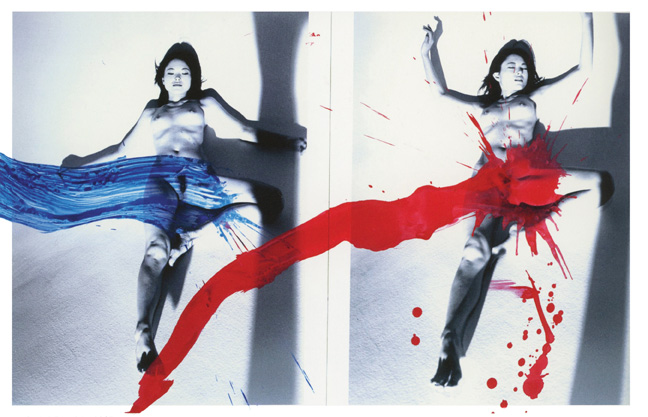« Reviews
The Incomplete Araki: Sex, Life, and Death in the Works of Nobuyoshi Araki
Museum of Sex - New York
By Taliesin Thomas
I have long admired the lusty photographer Arākī (Nobuyoshi Araki, b. 1940) for his blatant erotica, yet in the wake of recent controversies lighting up the media and exposing deplorable male behaviors toward women, I had to reconsider my Araki affinity during a recent visit to his retrospective at the Museum of Sex in New York. For those unfamiliar with his work, “The Incomplete Araki: Sex, Life, and Death in the works of Nobuyoshi Araki” offers a comprehensive look at Araki’s provocative oeuvre, including many of his iconic photos, video footage of his collaborations, a wall of Polaroids, and an impressive collection of publications that chronicle his salacious artistic vision over many decades.
While the sweeping #MeToo movement has sparked outrage across all sectors of society, the protean realm of art illustrates sexual agitations writ large. In that regard, “The Incomplete Araki” provides a bold look at two sides of the questionable imagery that comprises the Araki narrative: the bawdy and the benevolent. On the one hand, his ribald images of couples fornicating or performing oral sex, porcelain Japanese women in kimonos tied up with legs splayed, or innocent schoolgirls in uniform bound by thick ropes and hanging from the ceiling invite unease and distaste. On the other hand, his simplistic photographs of orchids, fruits, clouds, empty streets and visions of his late wife isolated on a lonely train car highlight the ways in which these captured moments are naturally compelling. But Araki is Araki, and the crude dimensions of his art are certain. One of my favorite images from the show features revelers cavorting at an underground Tokyo nightclub-they laugh wildly as a seated woman joyfully urinates carelessly onto this delighted crowd of onlookers. One cannot help but smile at the absurdity of this scene.

Nobuyoshi Araki, KaoRi Love (diptych), 2007, acrylic paint on two black and white prints. Courtesy of the Museum of Sex.
Araki’s career spans nearly 60 years, and he is widely considered a celebrity and one of the most prolific photographers of all time, having published an immense body of work that includes more than 400 books and having exhibited in more than 280 solo shows worldwide. Eschewing the social and legal norms surrounding sexuality in his native Japan, Araki has always defied the canon with his combination of smut and sensitivity toward his subjects, often expressing both qualities in a single photo. One such example is KaoRi Love (Diptych) from 2007, which features his once-muse KaoRi on a pristine white floor splattered with red and blue paint, an obvious metaphor to male ejaculation. Her supple form and graceful aura symbolize the beauty of raw female flesh in the famed “floating world” (ukiyo-e) of Japanese aesthetics. The unfortunate footnote here is that KaoRi collaborated with Araki for 15 years, but she recently came forward to denounce his lack of professionalism and respect for her.
Although Araki has long been accepted as a kind of sophisticated “dirty old man” whose work explores and exploits the sexual poetry of Japanese culture, “The Incomplete Araki” offers an expanded view of Araki’s art and his treatment of the female subject. Araki will always be part artist-pervert, part carnal-dramatist. A black-and-white photo of Lady Gaga for Vogue Hommes Japan taken in 2011 is a poignant example of Araki’s ability to present the lewd as something to celebrate. In this image, the combination of Gaga’s superstardom and Araki’s signature bondage demonstrate a potent fusion of sex appeal, artistic transgression and outright personality power. Her deadpan look at the camera begs this question about the construction, fetishization and objectification of a sex symbol: What is your definition of sexy?
(February 8, 2017 - August 31, 2018)
Taliesin Thomas is an artist-philosopher, writer, educator and aesthetician based in Brooklyn, N.Y. She is the founding director of AW Asia (2007 - present). Thomas has lectured widely on contemporary Chinese art. She has published in Yishu: Journal of Contemporary Chinese Art, Journal of Contemporary Chinese Art (JCCA) and ArtAsiaPacific magazine in addition to offering regular reviews for ARTPULSE. She received an M.A. in East Asian Studies from Columbia University and is a Ph.D. candidate in art theory and philosophy with IDSVA concurrent with her professional role in the art world.
Filed Under: Reviews



































Leave a Reply
You must be logged in to post a comment.